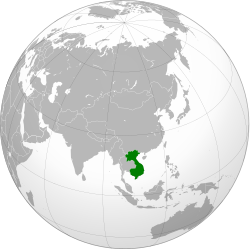
Back الهند الصينية الفرنسية Arabic Indochina francesa AST Fransa Hind-Çini Azerbaijani فرانسه چین هیندی AZB Француз Һинд-Ҡытайы Bashkir Indotsinang Pranses BCL Французскі Індакітай Byelorussian Френски Индокитай Bulgarian ফরাসি ইন্দোচীন Bengali/Bangla Indez-Sina c'hall Breton
Indochinese Union Union Indochinoise (French) 聯邦東洋 (Vietnamese) 印度支那聯邦 (Chinese) ສະຫະພາບອິນດູຈີນ (Lao) សហភាពឥណ្ឌូចិន (Khmer) | |
|---|---|
| 1887–1954 | |
| Motto: "Liberté, égalité, fraternité" "Liberty, Equality, Fraternity" | |
| Anthem: La Marseillaise ("The Marseillaise") | |
Vietnamese-style seal of the Governor-General of French Indochina[b] | |
 Map of French Indochina, excluding Guangzhouwan | |
| Status | Federation of French colonial possessions |
| Capital |
|
| Common languages | French (official) |
| Ethnic groups (1936)[2] | |
| Religion | |
| Demonym(s) | Indochinese |
| Membership | [d] |
| Governor-General | |
• 1887–1888 (first) | Ernest Constans |
• 1955–1956 (last) | Henri Hoppenot[e] |
| Historical era | New Imperialism |
| 1858–1885 | |
• French Cochinchina established | 17 October 1862 |
| 19 April 1899 | |
• Addition of Guangzhouwan | 5 January 1900 |
| 22 September 1940 | |
| Oct. 1940 – May 1941 | |
| 9 March 1945 | |
| 2 September 1945 | |
| 13 September 1945 | |
| 19 December 1946 | |
| 21 July 1954 | |
| Area | |
• Total | 737,000 km2 (285,000 sq mi) |
| Population | |
• 1900 | 15,164,500 |
• 1937 | 23,300,000 |
| Currency | French Indochinese piastre |
| Today part of | Vietnam Laos Cambodia China ∟Zhanjiang |
| |
French Indochina (previously spelled as French Indo-China),[a][b] officially known as the Indochinese Union[c][d] and after 1947 as the Indochinese Federation,[e] was a grouping of French colonial territories in Mainland Southeast Asia until its end in 1954. It comprised Cambodia, Laos (from 1899), the Chinese territory of Guangzhouwan (from 1898 until 1945), and the Vietnamese regions of Tonkin in the north, Annam in the centre, and Cochinchina in the south. The capital for most of its history (1902–1945) was Hanoi; Saigon was the capital from 1887 to 1902 and again from 1945 to 1954.
The Second French Empire annexed Cochinchina in 1862 and established a protectorate in Cambodia in 1863. After the French Third Republic took over northern Vietnam through the Tonkin campaign, the various protectorates were consolidated into one union in 1887. Two more entities were incorporated into the union: the Laotian protectorate and the Chinese territory of Guangzhouwan. The French exploited the resources in the region during their rule, but also contributed to improvements of the health and education system in the region. Nevertheless, deep divides remained between the native population and the colonists, leading to sporadic rebellions by the former. After the Fall of France during World War II, the colony was administered by the Vichy government and was under Japanese occupation until March 1945, when the Japanese overthrew the colonial regime. After the Japanese surrender, the Viet Minh, led by Hồ Chí Minh, declared Vietnamese independence, but France subsequently took back control of French Indochina with the help of the British. An all-out independence war, known as the First Indochina War, broke out in late 1946 between French and Viet Minh forces.
To counter the Viet Minh, the State of Vietnam, led by former Emperor Bảo Đại, was proclaimed by the French in 1949. French efforts to retake Vietnam were unsuccessful, culminating in defeat at the Battle of Điện Biên Phủ. On 22 October and 9 November 1953, the Kingdom of Laos and Kingdom of Cambodia proclaimed their respective independences. Following the Geneva Accord of 1954, the French were forced to withdraw from Vietnam, which had been split into the two countries (until 1976), and French Indochina was no more.
- ^ Lecompte, Jean. Monnaies et jetons de l'Indochine Française. (Principality of Monaco, 2013) Quote: "Les légendes sont bien sûr modifiées. A gauche, les attributs de l'agriculture et des beaux-arts sont remplacés par des épis de riz et à droite figure une ancre symbolisant le ministère de la Marine et des Colonies. Hélas, Albert-Désiré Barre décède le 29 décembre 1878 et c'est alors son frère aîné Auguste-Jean Barre qui lui succède et mène à terme le projet. Les premières frappes sortent en 1879." (in French))
- ^ "French Indo-China: Demographic Imbalance and Colonial Policy". Population Index. 2 (11): 68–81. 1945. doi:10.2307/2730333. JSTOR 2730333 – via JSTOR.
Cite error: There are <ref group=lower-alpha> tags or {{efn}} templates on this page, but the references will not show without a {{reflist|group=lower-alpha}} template or {{notelist}} template (see the help page).
© MMXXIII Rich X Search. We shall prevail. All rights reserved. Rich X Search

![Great Seal[a] of French Indochina](http://upload.wikimedia.org/wikipedia/commons/thumb/f/ff/French_Indo-Chinese_version_of_the_Great_Seal_of_the_French_Republic_%28Jean_Auguste_Barre%29.svg/85px-French_Indo-Chinese_version_of_the_Great_Seal_of_the_French_Republic_%28Jean_Auguste_Barre%29.svg.png)